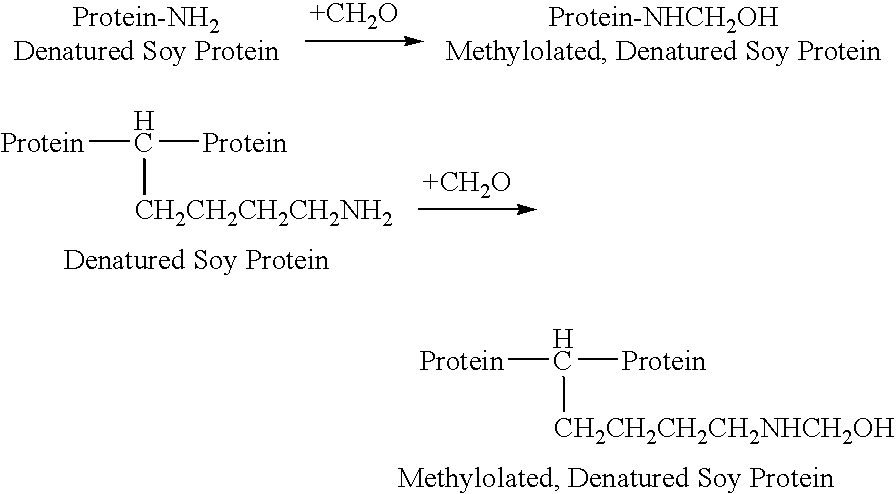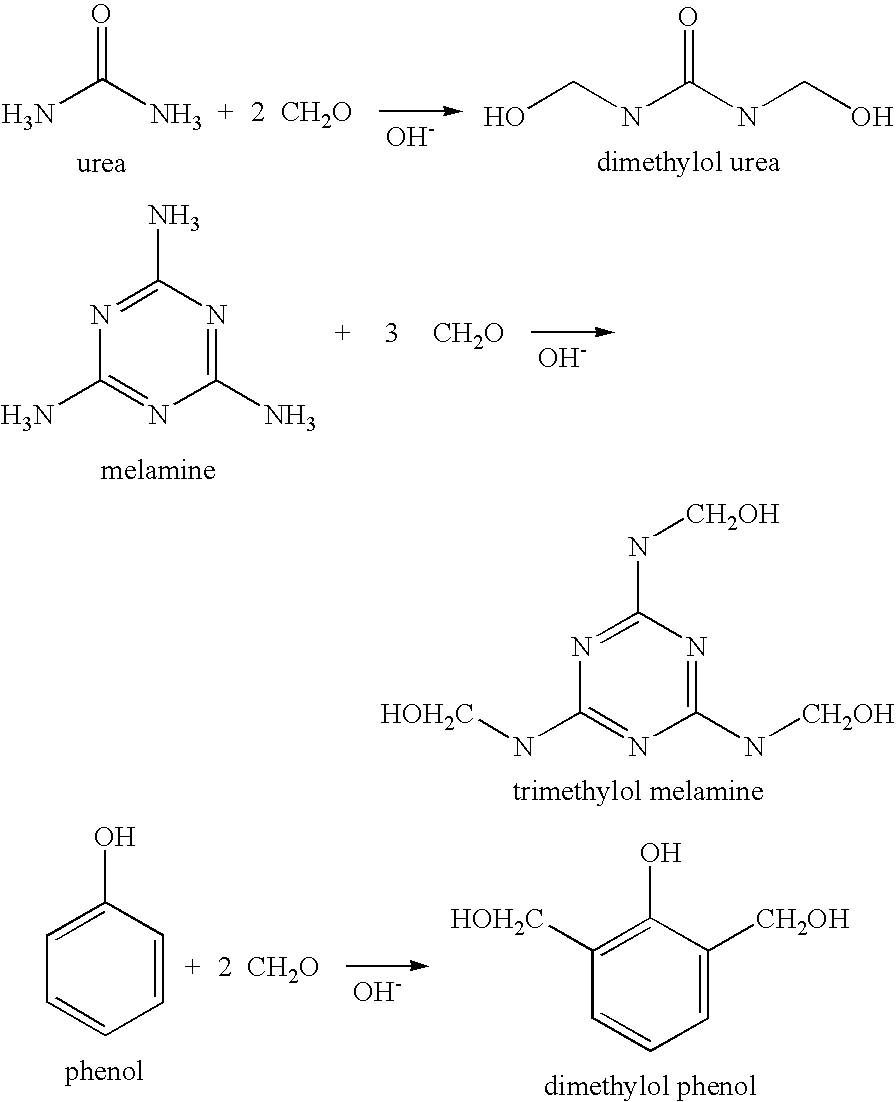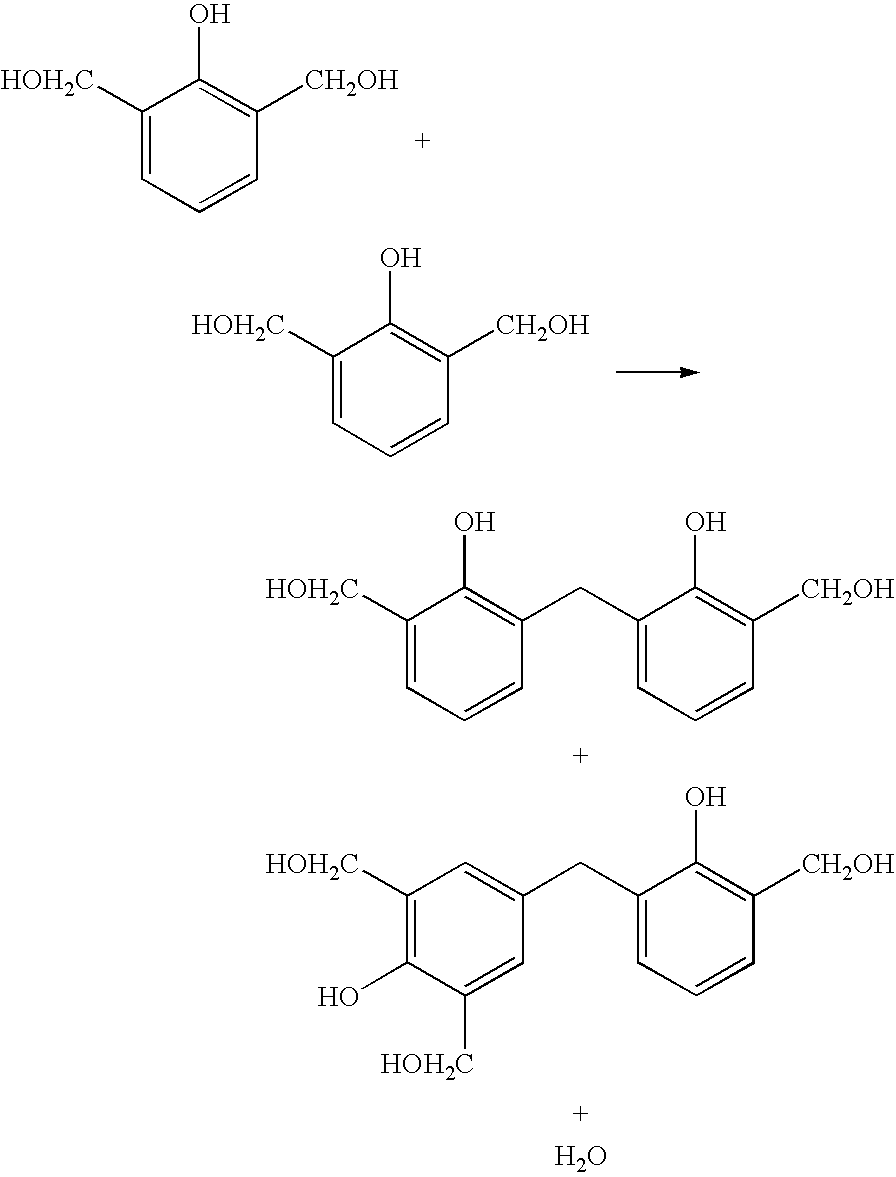Water-resistant vegetable protein adhesive dispersion compositions
a vegetable protein and composition technology, applied in the field of water-resistant vegetable protein adhesive dispersion compositions, can solve the problems of resins not showing satisfactory stability, resins that cannot compete with the standard phenol-formaldehyde resin in all aspects, and water-soluble adhesives that retain water solubility after drying or curing do not offer the exterior durability properties required in many composite panel applications, etc., to achieve the effect of reducing the cost of thermoset resin raw materials, reducing the cost of thermos
- Summary
- Abstract
- Description
- Claims
- Application Information
AI Technical Summary
Benefits of technology
Problems solved by technology
Method used
Image
Examples
example 2
[0129] A resin was prepared by combining components in the order as listed in Table 2 to yield a 70 / 30 phenol formaldehyde soy resin with 100 % low molecular weight phenol formaldehyde.
TABLE 2Stage ISequenceIngredientAmount (g)% to Soy01Water220.002NaOH 100%6.88.003Ethylene Glycol1.31.504Soy Flour85.0Stage IISequenceIngredientAmount (g)Moles to Phenol05Formaldehyde 37%122.01.0406Phenol 100%136.11.0007NaOH 100%5.80.1008Formaldehyde 37%122.01.0409NaOH 100%2.90.0510NaOH 100%2.90.05Total704.8
[0130] In Stage 1, water was combined with NaOH and ethylene glycol with mixing. The mixture was heated to 70° C. with modest agitation. Soy flour was added to the mixture at 5% of the total soy flour per minute with rapid stirring. The mixture was heated to 90° C. over 15 minutes, and maintained at a temperature of 88-92° C. for 1 hour.
[0131] In Stage 2, the mixture was removed from the heat source and charged with formaldehyde over 10 minutes, then the solution was maintained at 75° C. for 20 m...
example 3
[0132] A resin was prepared by combining components in the order as listed in Table 3 to yield a 60 / 40 phenol formaldehyde soy resin with 100 % low molecular weight phenol formaldehyde.
TABLE 3Stage ISequenceIngredientAmount (g)% to Soy01Water270.202NaOH 100%10.08.003Ethylene Glycol1.91.504Soy Flour125.0Stage IISequenceIngredientAmount (g)Moles to Phenol05Formaldehyde 37%115.41.0406Phenol 100%128.61.0007NaOH 100%5.50.1008Formaldehyde 37%115.41.0409NaOH 100%2.70.0510NaOH 100%2.70.05Total777.4
[0133] In Stage 1, water was combined with NaOH and ethylene glycol with mixing. The mixture was heated to 70° C. with modest agitation. Soy flour was added to the mixture at 5% of the total soy flour per minute with rapid stirring. The mixture was heated to 90° C. over 15 minutes, and maintained at a temperature of 88-92° C. for 1 hour.
[0134] In Stage 2, the mixture was removed from the heat source and charged with formaldehyde over 10 minutes, then the solution was maintained at 75° C. for 20...
example 4
[0135] A resin was prepared by combining components in the order as listed in Table 4 to yield a 60 / 40 phenol formaldehyde soy isolate resin with 100% low molecular weight phenol formaldehyde.
TABLE 4Stage ISequenceIngredientAmount (g)% to Soy01Water292.902NaOH 100%20.016.003Ethylene Glycol1.91.504Soy Isolates125.0Stage IISequenceIngredientAmount (g)Moles to Phenol05Formaldehyde 37%124.61.0406Phenol 100%139.01.0007NaOH 100%5.90.1008Formaldehyde 37%125.61.0409NaOH 100%3.90.0510NaOH 100%2.90.05Total839.8
[0136] In Stage 1, water was combined with NaOH and ethylene glycol with mixing. The mixture was heated to 70° C. with modest agitation. Soy isolates were added to the mixture at 5% of the total soy isolates per minute with rapid stirring. The mixture was heated to 90° C. over 15 minutes, and maintained at a temperature of 88-92° C. for 1 hour.
[0137] In Stage 2, the mixture was removed from the heat source and charged with formaldehyde over 10 minutes, then the solution was maintaine...
PUM
| Property | Measurement | Unit |
|---|---|---|
| temperature | aaaaa | aaaaa |
| temperature | aaaaa | aaaaa |
| temperature | aaaaa | aaaaa |
Abstract
Description
Claims
Application Information
 Login to View More
Login to View More - R&D
- Intellectual Property
- Life Sciences
- Materials
- Tech Scout
- Unparalleled Data Quality
- Higher Quality Content
- 60% Fewer Hallucinations
Browse by: Latest US Patents, China's latest patents, Technical Efficacy Thesaurus, Application Domain, Technology Topic, Popular Technical Reports.
© 2025 PatSnap. All rights reserved.Legal|Privacy policy|Modern Slavery Act Transparency Statement|Sitemap|About US| Contact US: help@patsnap.com



